Juvenile and Trash Fish Excluder Device (JTED) for Taiwanese Bottom Trawl
Abstract
1. Introduction
2. Materials and Methods
2.1. Design of Proposed JTED
- This study referenced 20-to-50-t Taiwanese trawlers with single boat bottom otter trawls, and these trawls had sorters that were made of stainless steel and had a circular shape for durability and rust resistance. The upper half of the sorter was the sorting area; catch that came into contact with this screen could escape from the trawl. The lower half was divided into two sections. The upper section was the guide board, which was bent 45° from the bottom of the sorting area toward the end of the codend. It guided the catch that could not pass through the sorter toward the bottom of the trawl. The lower section was an empty region that drove the catch that could not pass through the sorter to swim toward the end of codend, where it was trapped.
- Considering the codend specifications and the width of the net hauling channel at the quarter of the reference trawlers, this study set the frame diameters in two sorter designs to 131 cm (Figure 2 and Figure 3). The reference trawlers usually carried two or more trawls. One trawl was rolled on the net hauler for use, whereas spare trawls were stored in the net hold at the quarter of the fishing boat. However, because the aforementioned frame diameters in the two sorters were larger than the opening of the net hold (the maximum diagonal length was 115 cm), the diameter of the third designed sorter was set at 110 cm (Figure 4).
- In the present day, Taiwan’s bottom otter trawlers use codends with 20-mm meshes, and the diamond-shaped meshes open horizontally during trawling. If the trawl is completely open (90°) during trawling, the maximum horizontal opening of the mesh is 14.3 mm. Therefore, a grid interval of 15 mm was chosen for the first sorter design (JTED(15mm)). Because the diamond-shaped meshes of codends used by Taiwan’s bottom otter trawlers open 60° during trawling and because the opening is approximately 10 mm, a grid interval of 10 mm was chosen for the second sorter design (JTED(10mm)). For the third sorter design, a larger grid interval (20 mm) and mesh angle were selected (JTED(20mm)).
2.2. Experimental Vessel and JTED Installation Method
2.3. Test Conditions
3. Results
3.1. Notable Observations from Underwater Photographs
3.1.1. Fish
3.1.2. Cephalopods
3.1.3. Crabs
3.2. Composition of Catches
3.3. Overall JTED Performance
- JTED(20mm), JTED(15mm), and JTED(10mm) excluded the most to least marketable catches, respectively; the ratios of excluded marketable catch weight to total catch weight were 41.2%, 21.5%, and 3.2%, respectively. JTED(20mm), JTED(15mm), and JTED¬(10mm) excluded the least to most bycatch, respectively; the ratios of excluded bycatch weight to total catch weight were 53.8%, 69.2%, and 94.3%, respectively.
- More marketable catch was excluded when the grid interval was higher. For example, the weight of Trichiurus japonicas fishes excluded comprised 1%, 25.6%, and 70.1% of the total weight of T. japonicas fishes caught, respectively. For Loliginidae, the corresponding figures were 9.8%, 58.1%, and 61.7% for JTED(20mm), JTED(15mm), and JTED¬(10mm), respectively. With regard to bycatch exclusion, JTED(10mm) performed the worst and JTED(15mm) and JTED(20mm) had similar performance except for Equulites rivulatus, Acropoma japonicum, Benthosema pterotum, and Photopectoralis aureus, in which JTED(15mm) outperformed JTED(20mm).
3.4. Commercial Loss from JTEDs
3.4.1. Fish
3.4.2. Crustaceans
3.4.3. Cephalopods
4. Discussion
4.1. Comparison of the Proposed JTED with Existing JTEDs
4.2. Exclusion Performance of JTED Grid Intervals
4.3. Discrimination in Excluding Bycatch and Including Target Catch for Each Grid Interval
4.4. Future Improvements to Proposed JTEDs
5. Conclusions
Author Contributions
Funding
Institutional Review Board Statement
Data Availability Statement
Acknowledgments
Conflicts of Interest
References
- Ye, Y.; Alsaffar, A.H.; Mohammed, H.M.A. Bycatch and discards of the Kuwait shrimp fishery. Fish. Res. 2000, 45, 9–19. [Google Scholar] [CrossRef]
- Cosgrove, R.; Browne, D.; Minto, C.; Tyndall, P.; Oliver, M.; Montgomerie, M.; McHugh, M. A game of two halves: Bycatch reduction in Nephrops mixed fisheries. Fish. Res. 2019, 210, 31–40. [Google Scholar] [CrossRef]
- Pérez Roda, M.A.; Gilman, E.; Huntington, T.; Kennelly, S.J.; Suuronen, P.; Chaloupka, M.; Medley, P.A.H. A Third Assessment of Global Marine Fisheries Discards (FAO Fisheries and Aquaculture Technical Paper No. 633); Food and Agriculture Organization of the United Nations: Rome, Italy, 2019. [Google Scholar]
- Davis, R.W.D.; Cripps, S.J.; Nickson, A.; Porter, G. Defining and estimating global marine fisheries bycatch. Mar. Policy 2009, 33, 661–672. [Google Scholar] [CrossRef]
- Abdulqader, E.A.A.; Abdurahiman, P.; Mansour, L.; Harrath, A.H.; Qurban, M.A.; Rabaoui, L. Bycatch and discards of shrimp trawling in the Saudi waters of the Arabian Gulf: Ecosystem impact assessment and implications for a sustainable fishery management. Fish. Res. 2020, 229, 105596. [Google Scholar] [CrossRef]
- Broadhurst, M.K.; Suuronen, P.; Hulme, A. Estimating collateral mortality from towed fishing gear. Fish Fish. 2006, 7, 180–218. [Google Scholar] [CrossRef]
- Parker, S.J.; McElderry, H.I.; Rankin, P.S.; Hannah, R.W. Buoyancy regulation and barotrauma in two species of nearshore rockfish. Trans. Am. Fish. Soc. 2006, 135, 1213–1223. [Google Scholar] [CrossRef]
- Benoît, H.; Hurlbut, T.; Chassé, J. Assessing the factors influencing discard mortality of demersal fishes in four fisheries using a semi-quantitative indicator of survival potential. Fish. Res. 2010, 106, 436–447. [Google Scholar] [CrossRef]
- Courtney, A.J.; Campbell, M.J.; Tonks, M.L.; Roy, D.P.; Gaddes, S.W.; Haddy, J.A.; Kyne, P.M.; Mayer, D.G.; Chilcott, K.E. Effects of bycatch reduction devices in Queensland’s (Australia) deepwater eastern king prawn (Melicertus plebejus) trawl fishery. Fish. Res. 2014, 157, 113–123. [Google Scholar] [CrossRef]
- Broadhurst, M.K.; Brand, C.P.; Kennelly, S.J. Evolving and devolving bycatch reduction devices in an Australian penaeid-trawl fishery. Fish. Res. 2012, 113, 68–75. [Google Scholar] [CrossRef]
- He, P.; Balzano, V. Rope Grid: A new grid design to further reduce finfish bycatch in the Gulf of Maine pink shrimp fishery. Fish. Res. 2011, 111, 100–107. [Google Scholar] [CrossRef]
- He, P.; Balzano, V. A new shrimp trawl combination grid system that reduces small shrimp and finfish bycatch. Fish. Res. 2013, 140, 20–27. [Google Scholar] [CrossRef]
- Kajikawa, Y.; Tokai, T.; Hu, F. Improvement of species- and size-separation in SURF-BRD with high encounter probability of marine organisms. Nippon Suisan Gakkaishi 2009, 75, 219–229. [Google Scholar] [CrossRef]
- Kajikawa, Y.; Tokai, T.; Hu, F. Modeling of available size selectivity of the SURF-BRD for shrimp beam trawl. Fish. Sci. 2013, 79, 879–894. [Google Scholar] [CrossRef]
- Larsen, R.B.; Herrmann, B.; Sistiag, M.; Grimaldo, E.; Tatone, I.; Onandia, I. Size selection of redfish (Sebastes spp.) in a double grid system: Estimating escapement through individual grids and comparison to former grid trials. Fish. Res. 2016, 183, 385–395. [Google Scholar] [CrossRef]
- Larsen, R.B.; Herrmann, B.; Sistiag, M.; Brinkhof, J.; Grimaldo, E. Bycatch reduction in the Norwegian Deep-water Shrimp (Pandalus borealis) fishery with a double grid selection system. Fish. Res. 2018, 208, 267–273. [Google Scholar] [CrossRef]
- Eayrs, S. A Guide to Bycatch Reduction in Tropical Shrimp-Trawl Fisheries; Food and Agriculture Organization of the United Nations: Rome, Italy, 2007. [Google Scholar]
- Chokesanguan, B.; Ananpongsuk, S.; Siriraksophon, S.; Podapol, L. Study on Juvenile and Trash Excluder Devices (JTEDs) in Thailand (SEAFDEC.TD/RES/47); Southeast Asian Fisheries Development Center: Samut Prakan, Thailand, 2000. [Google Scholar]
- Chokesanguan, B.; Ananpongsuk, S.; Siriraksophon, S.; Ali, R. Study on Juvenile and Trash Excluder Devices (JTEDs) in Malaysia (SEAFDEC.TD/RES/72); Southeast Asian Fisheries Development Center: Samut Prakan, Thailand, 2002. [Google Scholar]
- Chokesanguan, B.; Ananpongsuk, S.; Chanrachakij, I.; Manajit, N.; Tampubolon, G.H. Study on Juvenile and Trash Excluder Devices (JTEDs) in Indonesia (SEAFDEC.TD/RES/83); Southeast Asian Fisheries Development Center: Samut Prakan, Thailand, 2003. [Google Scholar]
- Chokesanguan, B.; Ananpongsuk, S.; Chanrachakij, I.; Wanchana, W.; Long, N. Study on Juvenile and Trash Excluder Devices (JTEDs) in Vietnam (SEAFDEC.TD/RES/84); Southeast Asian Fisheries Development Center: Samut Prakan, Thailand, 2003. [Google Scholar]
- Chokesanguan, B.; Ananpongsuk, S.; Siriraksophon, S.; Abdul, H. Study on Juvenile and Trash Excluder Devices (JTEDs) in Brunei Darussalam (SEAFDEC.TD/RES/82); Southeast Asian Fisheries Development Center: Samut Prakan, Thailand, 2003. [Google Scholar]
- Chokesanguan, B.; Ananpongsuk, S.; Siriraksophon, S.; Yasook, N.; Dickson, J.O. Study on Juvenile and Trash Excluder Devices (JTEDs) in Philippines (SEAFDEC.TD/RES/81); Southeast Asian Fisheries Development Center: Samut Prakan, Thailand, 2003. [Google Scholar]
- Chokesanguan, B. The Promotion of Responsible Trawl Fishing Practices in Southeast Asia: A Summary on the Introduction of Juvenile and Trash Excluder Devices (JTEDs); International Institute of Fisheries Economics and Trade: Tokyo, Japan, 2004. [Google Scholar]
- Chokesanguan, B.; Ananpongsuk, S.; Siriraksophon, S.; Chanrachakij, I.; Yingyuad, W.; Suru, B.B. Study on Juvenile and Trash Excluder Devices (JTEDs) in Brunei Darussalam (SEAFDEC.TD/RES/95); Southeast Asian Fisheries Development Center: Samut Prakan, Thailand, 2005. [Google Scholar]
- Chokesanguan, B.; Ananpongsuk, S.; Ae, K.M.; Ko, W.K.; Yingyuad, W. Study on Juvenile and Trash Excluder Devices (JTEDs) in Myanmer (SEAFDEC.TD/RES/100); Southeast Asian Fisheries Development Center: Samut Prakan, Thailand, 2007. [Google Scholar]
- Chokesanguan, B.; Ananpongsuk, S.; Pethkam, R. Study on Juvenile and Trash Excluder Devices (JTEDs) in Cambodia (SEAFDEC.TD/RES/101); Southeast Asian Fisheries Development Center: Samut Prakan, Thailand, 2007. [Google Scholar]
- Chokesanguan, B.; Ananpongsuk, S.; Dickson, J.O.; Sulit, V. Reducing unwanted catch from trawl fisheries: Use of juvenile and trash fish excluder devices as fishing technology solution. Fish People 2010, 8, 20–26. [Google Scholar]
- Kajikawa, Y.; Fujiishi, A.; Nagamatsu, K.; Tokai, T.; Matuda, K. Species- and size-selectivity of SURF-BRD trawl. Nippon Suisan Gakkaishi 1999, 65, 278–287. [Google Scholar] [CrossRef]
- Sistiaga, M.; Brinkhof, J.; Herrmann, B.; Grimaldo, E.; Langård, L.; Lilleng, D. Size selective performance of two flexible sorting grid designs in the Northeast Arctic cod (Gadus morhua) and haddock (Melanogrammus aeglefinus) fishery. Fish. Res. 2016, 183, 340–351. [Google Scholar] [CrossRef]
- Larsen, R.B.; Herrmann, B.; Sistiag, M.; Grimaldo, E.; Tatone, I.; Brinkhof, J. Size selection of cod (Gadus morhua) and haddock (Melanogrammus aeglefinus) in the Northeast Atlantic bottom trawl fishery with a newly developed double steel grid system. Fish. Res. 2018, 201, 120–130. [Google Scholar] [CrossRef]
- Chang, K.Y.; Liao, C.H.; Huang, H.T.; Wu, C.L.; Wang, K.Y. Age and Growth of Uroteuthis (Photololigo) Chinensis, U. (P.) Duvauceli and U. (P.) Edulis from the waters around Taiwan. J. Taiwan Fish. Res. 2014, 22, 1–13. [Google Scholar]
- Herrmann, B.; Sistiaga, M.; Larsen, R.B.; Nielsen, K.N. Size selectivity of redfish (Sebastes spp.) in the Northeast Atlantic using grid-based selection systems for trawls. Aquat. Liv. Resourc. 2013, 26, 109–120. [Google Scholar] [CrossRef]
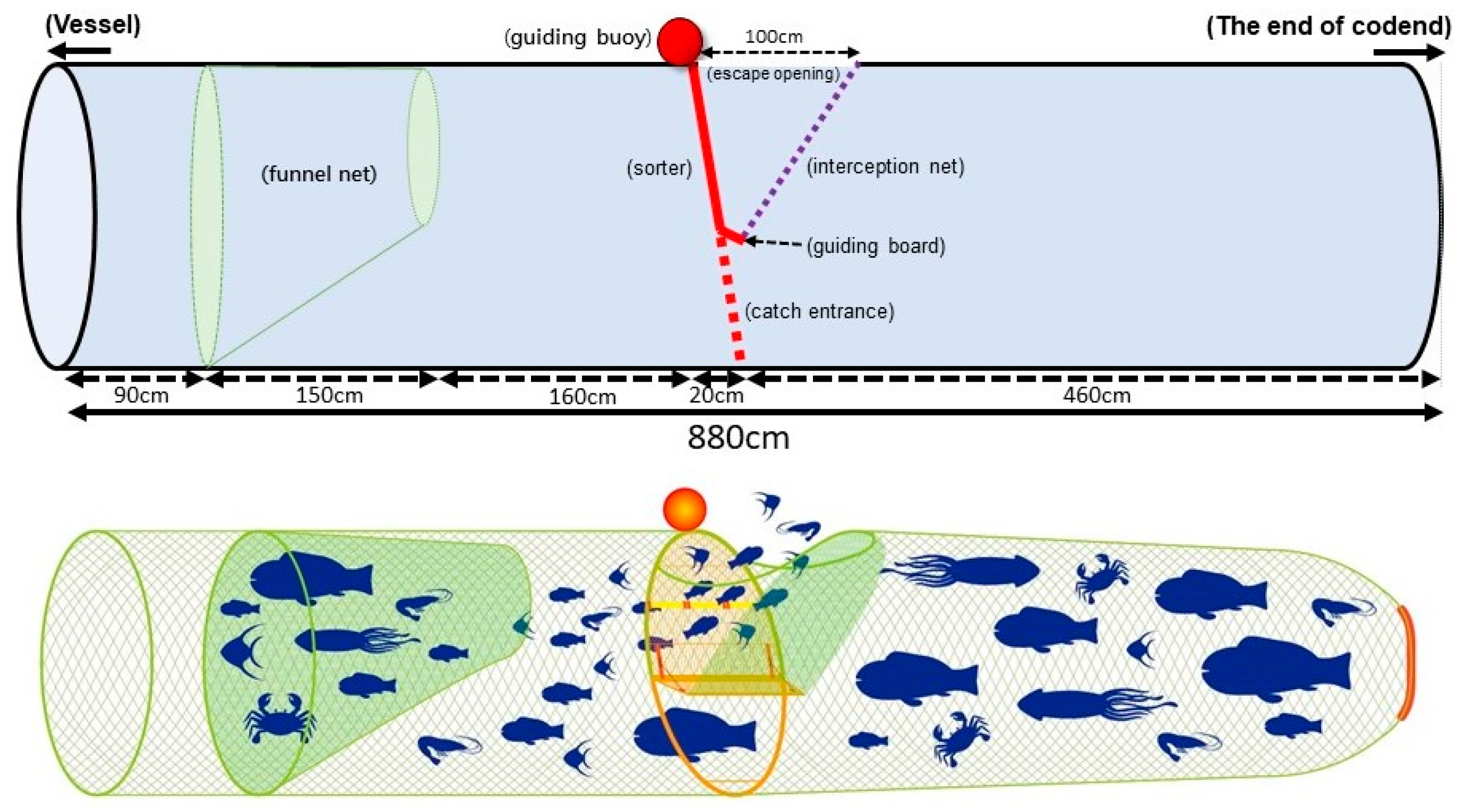
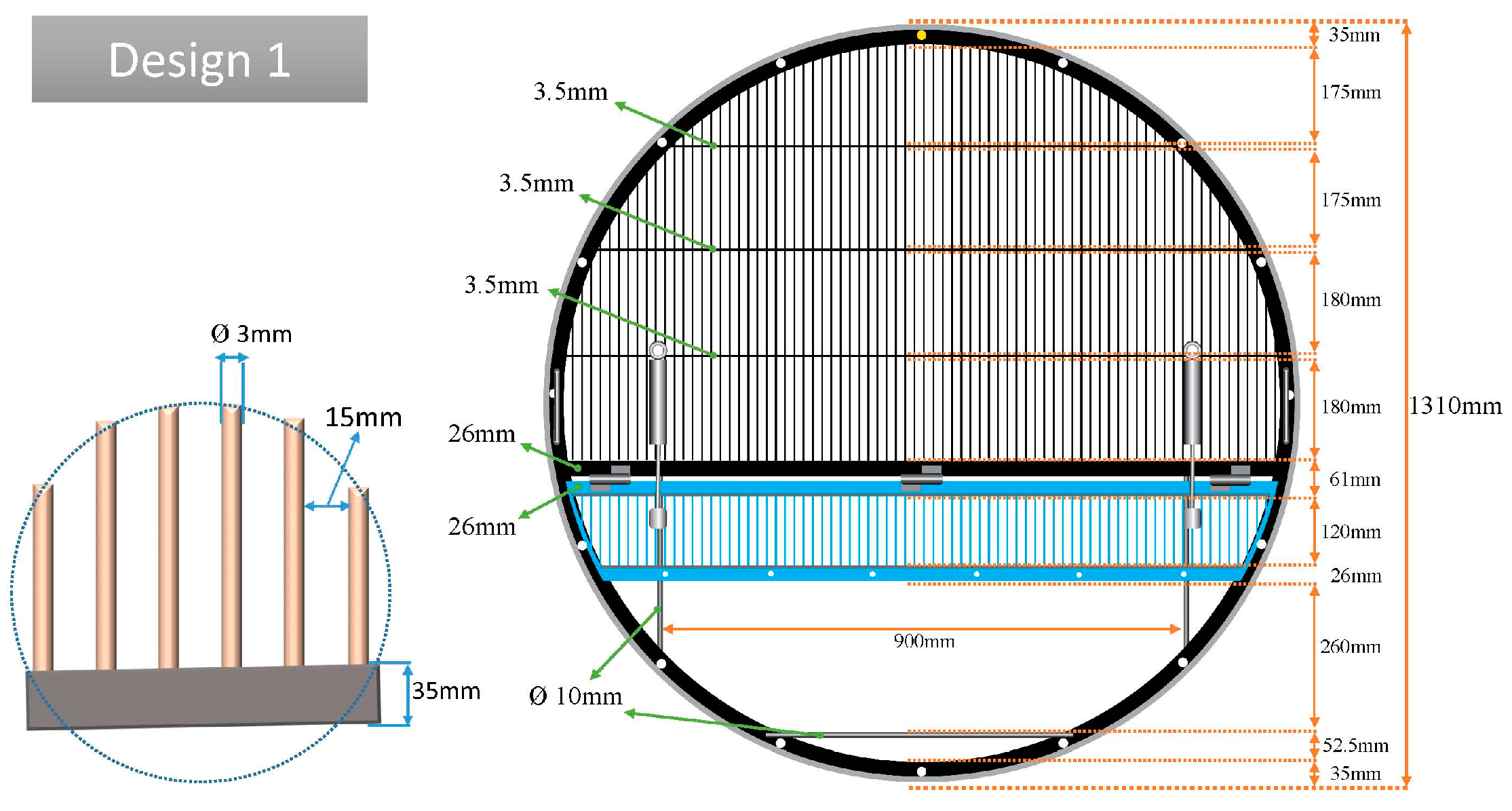
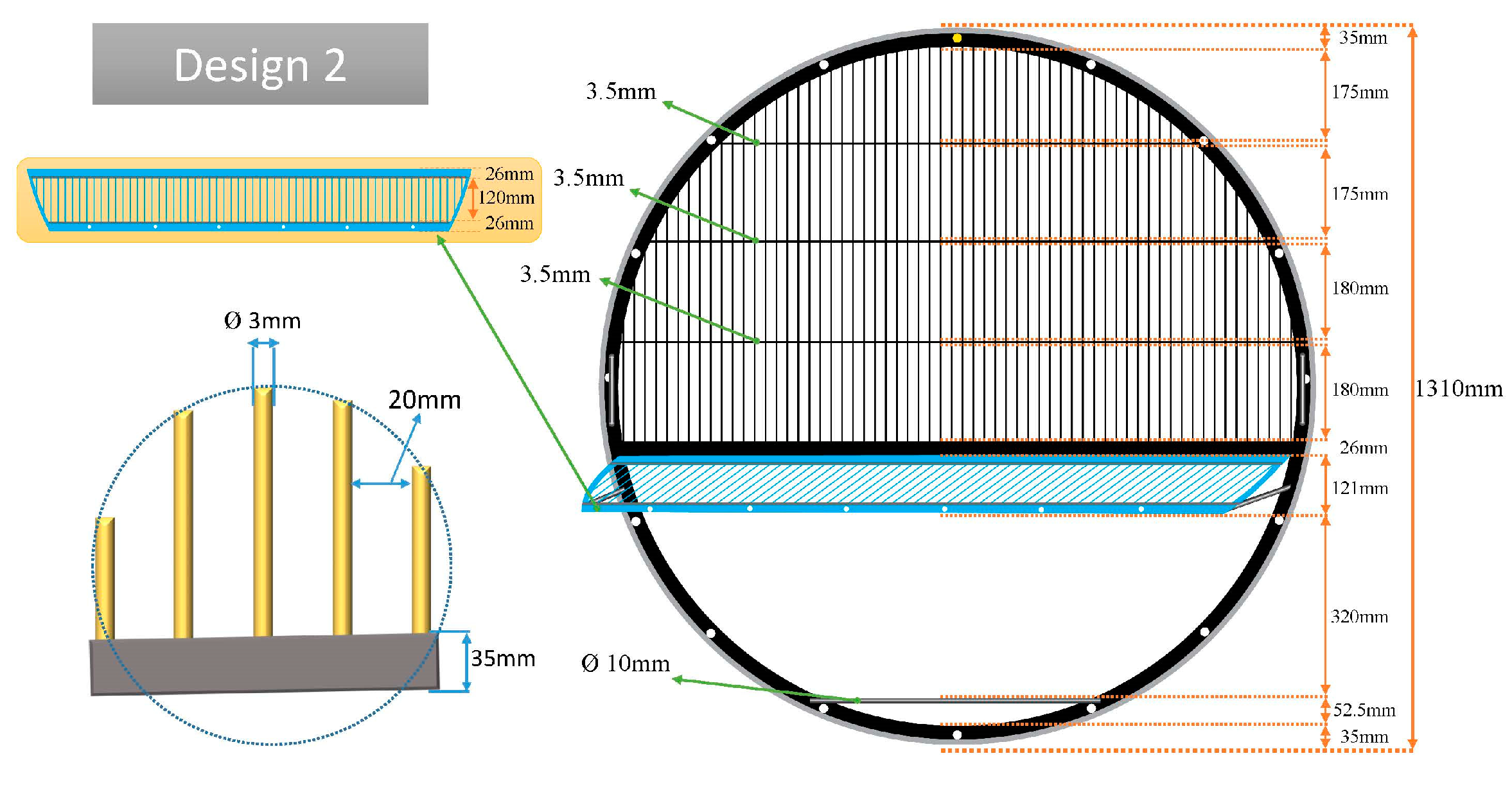
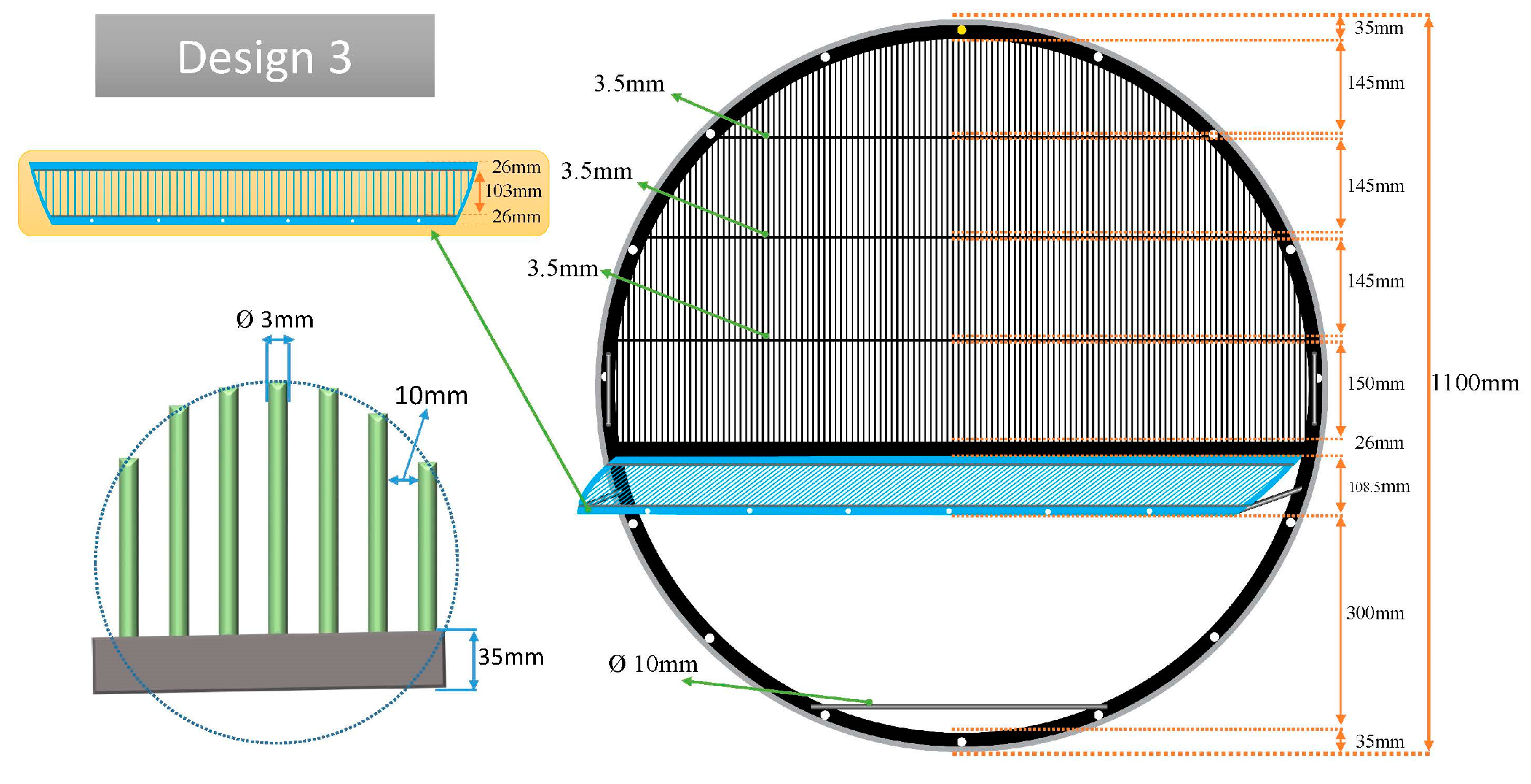
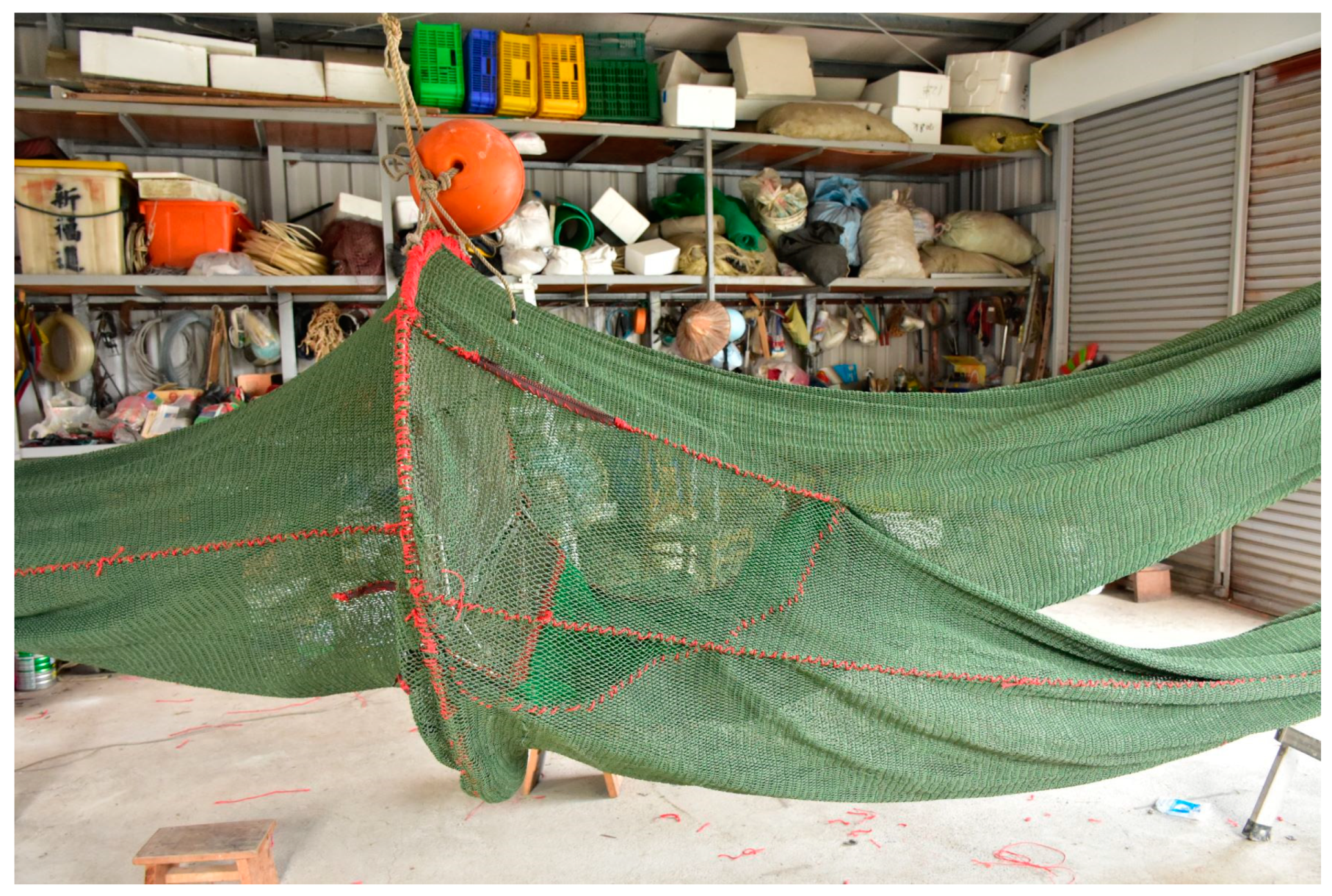
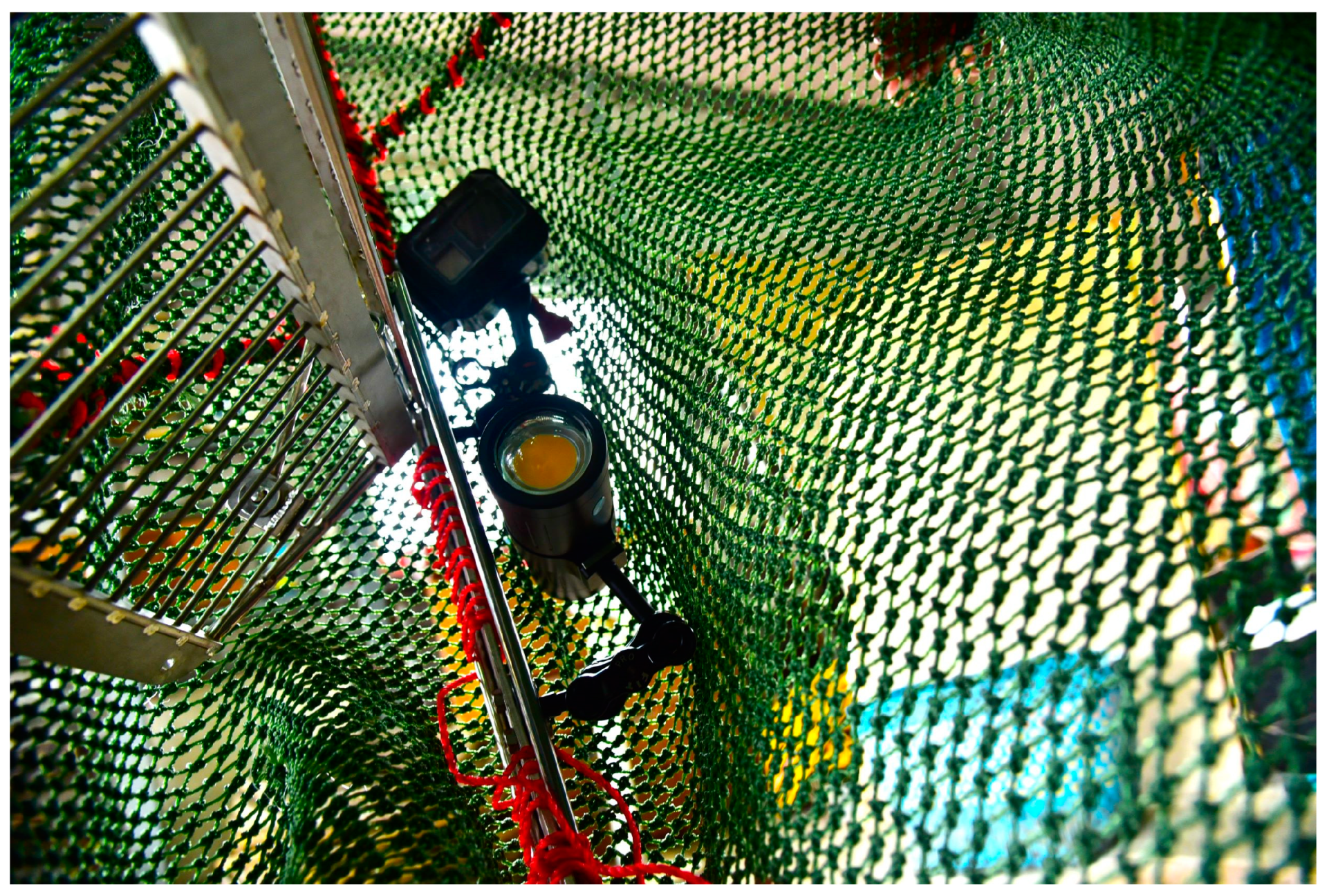
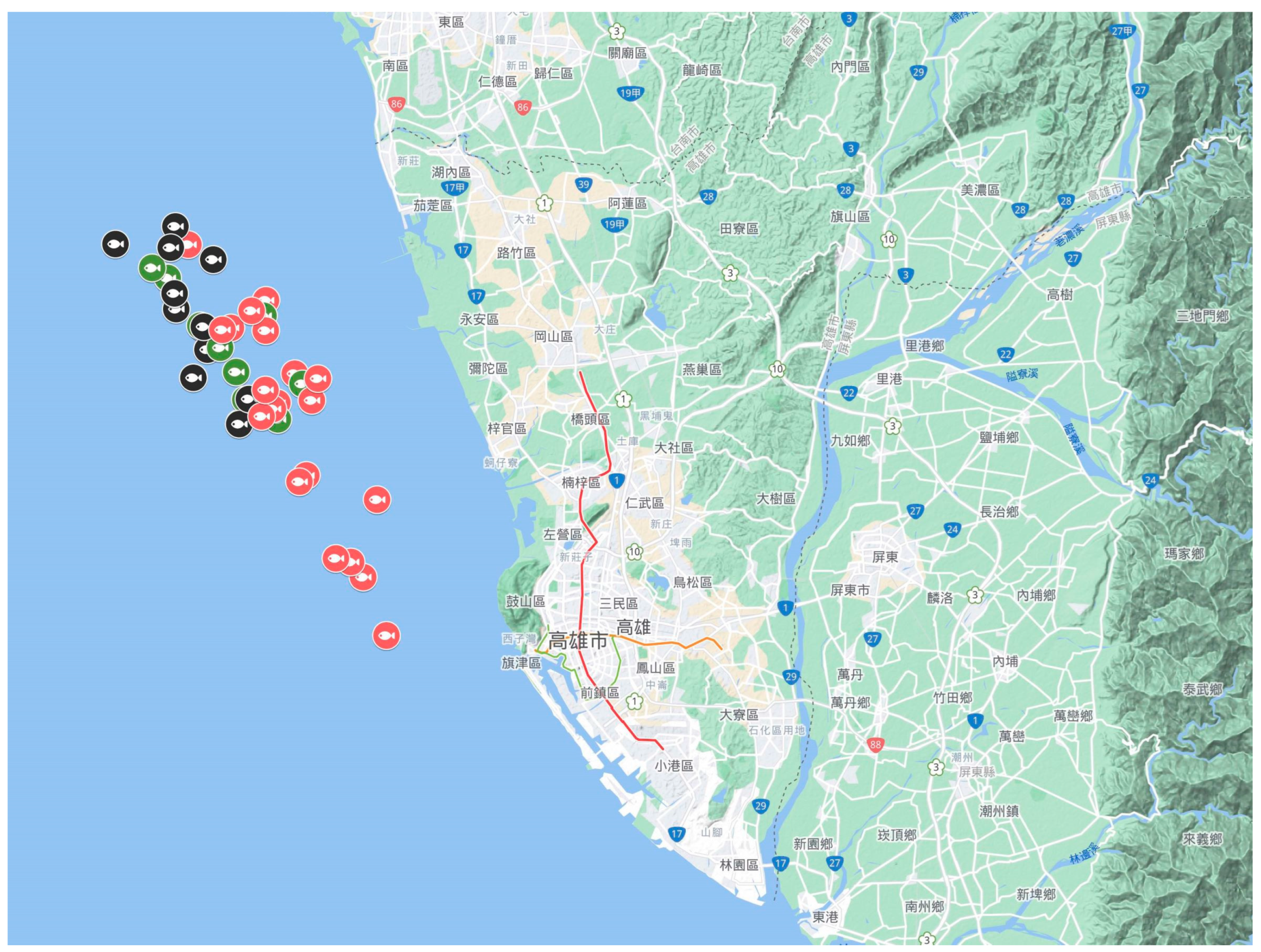
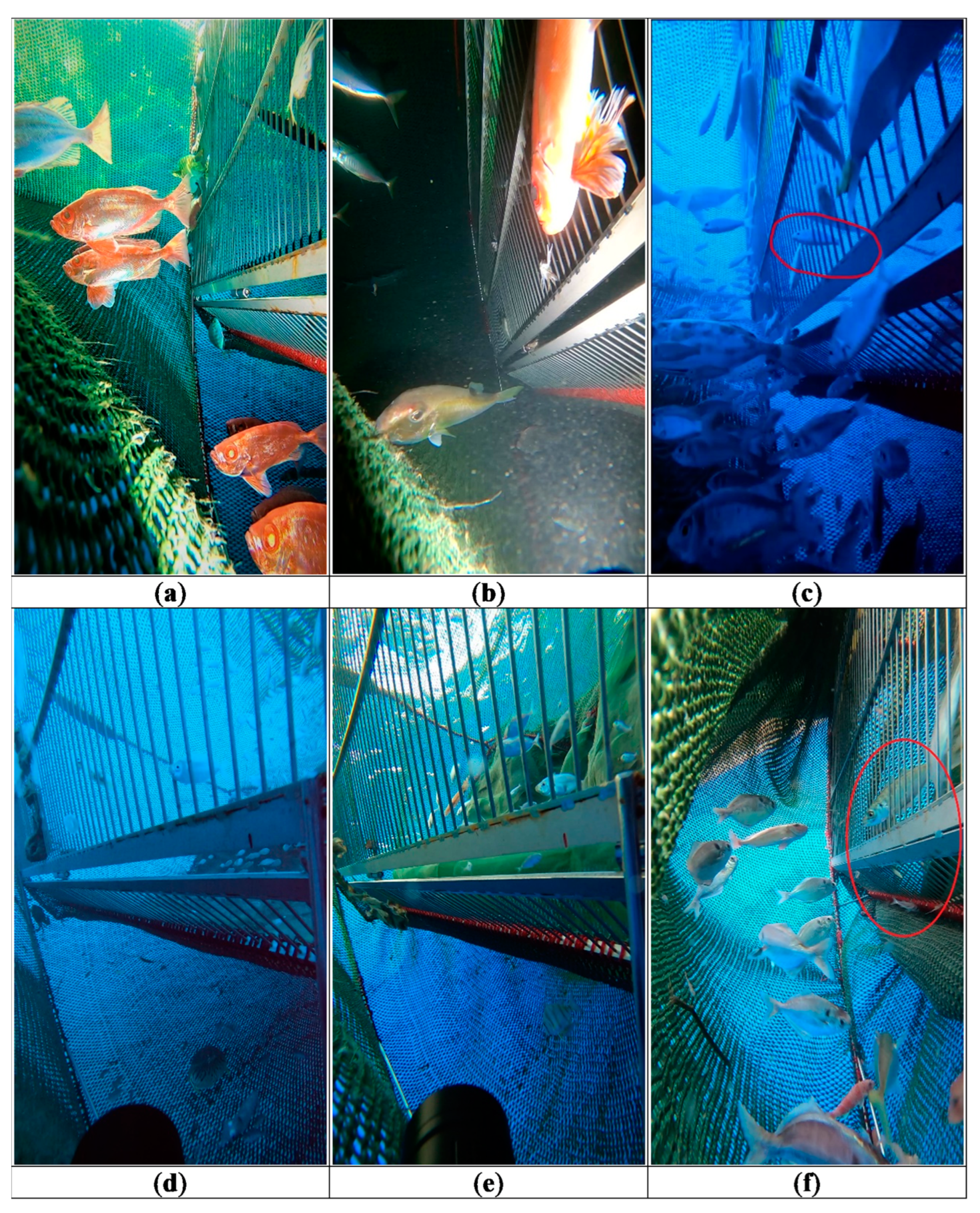
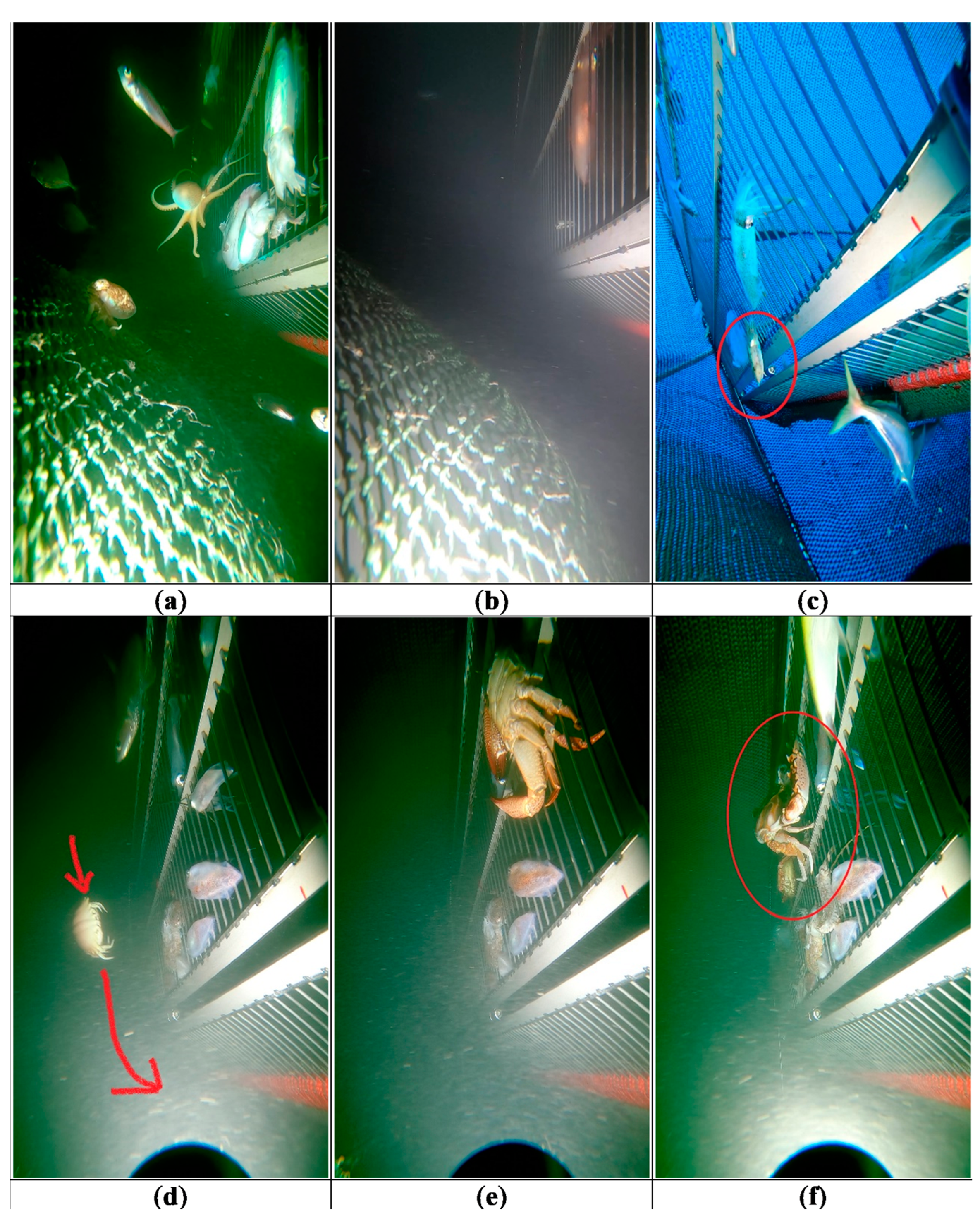
| Haul | Date | Grid Interval (mm) | (a) Weight of Samples (kg) | (b) Extrapolated Total Weight (kg) | Weight Ratio of Excluded Catch (%) (1/3) | ||||
|---|---|---|---|---|---|---|---|---|---|
| Cover Net | Codend | Subtotal | Cover Net (1) | Codend (2) | Subtotal (3) | ||||
| 1 | 20210430 | 15 | 0.97 | 11.51 | 12.5 | 0.97 | 11.51 | 12.5 | 7.8 |
| 2 | 20210430 | 15 | 1.16 | 21.24 | 22.4 | 1.16 | 21.24 | 22.4 | 5.2 |
| 3 | 20210430 | 15 | 2.30 | 10.33 | 12.6 | 9.78 | 26.77 | 36.5 | 26.8 |
| 4 | 20210430 | 15 | 2.04 | 10.33 | 12.4 | 5.49 | 18.37 | 23.9 | 23.0 |
| 5 | 20210430 | 15 | 1.87 | 7.82 | 9.7 | 4.30 | 14.56 | 18.9 | 22.8 |
| 6 | 20210513 | 15 | 4.88 | 11.55 | 16.4 | 29.30 | 11.55 | 40.8 | 71.7 |
| 7 | 20210513 | 15 | 4.04 | 10.87 | 14.9 | 12.12 | 11.41 | 23.5 | 51.5 |
| 8 | 20210513 | 15 | 2.63 | 5.49 | 8.1 | 7.88 | 10.96 | 18.8 | 41.8 |
| 9 | 20210513 | 15 | 1.24 | 8.25 | 9.5 | 1.24 | 8.25 | 9.5 | 13.0 |
| 10 | 20210513 | 15 | 1.25 | 18.60 | 19.9 | 1.25 | 18.60 | 19.9 | 6.3 |
| 11 | 20210603 | 15 | 2.72 | 13.81 | 16.5 | 5.44 | 22.18 | 27.6 | 19.7 |
| 12 | 20210603 | 15 | 2.15 | 10.44 | 12.6 | 5.90 | 12.21 | 18.1 | 32.6 |
| 13 | 20210603 | 15 | 1.72 | 9.92 | 11.6 | 1.72 | 9.92 | 11.6 | 14.8 |
| 14 | 20210603 | 15 | 2.91 | 7.67 | 10.6 | 2.91 | 7.67 | 10.6 | 27.5 |
| 15 | 20210603 | 15 | 3.00 | 10.72 | 13.7 | 3.00 | 10.72 | 13.7 | 21.8 |
| 16 | 20210610 | 15 | 2.84 | 14.49 | 17.3 | 8.53 | 29.11 | 37.6 | 22.7 |
| 17 | 20210610 | 15 | 2.11 | 13.85 | 16.0 | 4.79 | 13.85 | 18.6 | 25.7 |
| 18 | 20210610 | 15 | 1.71 | 9.10 | 10.8 | 1.71 | 9.10 | 10.8 | 15.8 |
| 19 | 20210610 | 15 | 3.29 | 7.14 | 10.4 | 8.47 | 11.23 | 19.7 | 43.0 |
| 20 | 20210610 | 15 | 2.48 | 9.68 | 12.2 | 2.48 | 9.68 | 12.2 | 20.4 |
| 21 | 20210709 | 20 | 4.88 | 12.47 | 17.3 | 11.51 | 12.47 | 24.0 | 48.0 |
| 22 | 20210709 | 20 | 4.51 | 7.88 | 12.4 | 4.51 | 7.88 | 12.4 | 36.4 |
| 23 | 20210709 | 20 | 1.86 | 12.99 | 14.9 | 1.86 | 12.99 | 14.9 | 12.5 |
| 24 | 20210709 | 20 | 4.75 | 9.46 | 14.2 | 47.52 | 79.99 | 127.5 | 37.3 |
| 25 | 20210709 | 20 | 2.28 | 5.91 | 8.2 | 2.28 | 5.91 | 8.2 | 27.8 |
| 26 | 20210819 | 20 | 4.67 | 9.82 | 14.5 | 7.93 | 9.82 | 17.7 | 44.7 |
| 27 | 20210819 | 20 | 3.84 | 6.65 | 10.5 | 3.84 | 6.65 | 10.5 | 36.6 |
| 28 | 20210819 | 20 | 1.93 | 8.12 | 10.0 | 1.93 | 8.12 | 10.0 | 19.2 |
| 29 | 20210819 | 20 | 5.99 | 12.69 | 18.7 | 5.99 | 12.69 | 18.7 | 32.1 |
| 30 | 20210819 | 20 | 4.48 | 5.07 | 9.5 | 4.48 | 5.07 | 9.5 | 46.9 |
| 31 | 20210823 | 10 | 2.54 | 9.65 | 12.2 | 2.54 | 9.65 | 12.2 | 20.9 |
| 32 | 20210823 | 10 | 2.26 | 18.03 | 20.3 | 2.26 | 18.03 | 20.3 | 11.1 |
| 33 | 20210823 | 10 | 2.14 | 21.09 | 23.2 | 2.14 | 27.14 | 29.3 | 7.3 |
| 34 | 20210823 | 10 | 1.04 | 14.87 | 15.9 | 1.04 | 14.87 | 15.9 | 6.5 |
| 35 | 20210823 | 10 | 0.43 | 36.15 | 36.6 | 0.43 | 36.15 | 36.6 | 1.2 |
| 36 | 20210826 | 10 | 1.57 | 9.10 | 10.7 | 1.57 | 9.10 | 10.7 | 14.7 |
| 37 | 20210826 | 10 | 0.11 | 4.77 | 4.9 | 0.11 | 4.77 | 4.9 | 2.3 |
| 38 | 20210826 | 10 | 0.32 | 6.50 | 6.8 | 0.32 | 6.50 | 6.8 | 4.7 |
| 39 | 20210826 | 10 | 0.79 | 4.17 | 5.0 | 0.79 | 4.17 | 5.0 | 15.9 |
| 40 | 20210826 | 10 | 0.97 | 10.68 | 11.7 | 0.97 | 10.68 | 11.7 | 8.4 |
| Subtotal | 10 | 12.17 | 135.01 | 147.17 | 12.17 | 141.06 | 153.22 | 7.9 | |
| 15 | 47.28 | 222.78 | 270.06 | 118.41 | 288.87 | 407.28 | 29.1 | ||
| 20 | 39.19 | 91.03 | 130.22 | 91.85 | 161.57 | 253.42 | 36.2 | ||
| Total | 98.6 | 448.8 | 547.5 | 222.4 | 591.5 | 813.9 | 27.3 | ||
| No. | Species | Weight Ratio of the Catch in the Cover Net (%) | Weight Ratio of the Catch Excluded by JTEDs (Cover Net/Codend) | |||||
|---|---|---|---|---|---|---|---|---|
| Total | 10 mm | 15 mm | 20 mm | 10 mm | 15 mm | 20 mm | ||
| Marketable catch | 21.0 | 3.2 | 21.5 | 41.2 | ||||
| 1 | Loliginidae | 10.9 | 1.7 | 16.7 | 10.4 | 9.8 | 58.1 | 61.7 |
| 2 | Trichiurus japonicus | 3.8 | 0.9 | 1.3 | 12.3 | 1.0 | 25.6 | 70.1 |
| 3 | Aurigequula fasciatus | 1.7 | - | - | 7.3 | - | - | 100.0 |
| 4 | Psenopsis anomala | 1.4 | - | - | 6.0 | - | - | 34.0 |
| 5 | Sepia madokai | 1.3 | 0.3 | 1.9 | 1.5 | 0.8 | 8.9 | 23.9 |
| 6 | Upeneus japonicus | 1.0 | 0.3 | 1.4 | 0.9 | 0.3 | 17.8 | 16.3 |
| 7 | Carangoides equula | 0.7 | - | 0.2 | 2.8 | - | 19.9 | 29.1 |
| Catch with little or no economic value | 73.3 | 94.3 | 69.2 | 53.8 | ||||
| 1 | Equulites rivulatus | 21.3 | 40.1 | 14.5 | 12.2 | 66.7 | 69.0 | 68.0 |
| 2 | Synagrops philippinensis | 12.7 | 28.1 | 5.0 | 9.7 | 38.8 | 60.7 | 64.9 |
| 3 | Acropoma japonicum | 10.8 | 1.7 | 21.3 | 1.0 | 19.7 | 46.9 | 38.7 |
| 4 | Metapenaeopsis provocatoria longiroitris | 6.1 | 4.0 | 7.5 | 5.9 | 36.8 | 56.7 | 63.0 |
| 5 | Benthosema pterotum | 4.9 | 5.4 | 5.6 | 2.6 | 75.9 | 98.9 | 93.1 |
| 6 | Photopectoralis aureus | 4.7 | 3.3 | 5.0 | 5.7 | 24.4 | 82.7 | 73.0 |
| 7 | Champsodon snyderi | 3.9 | 5.3 | 2.5 | 5.1 | 43.8 | 68.3 | 74.3 |
| 8 | Gymnothorax minor | 2.1 | 0.5 | 3.1 | 1.9 | 3.7 | 57.4 | 31.1 |
| 9 | Saurida umeyoshii | 1.6 | - | 2.7 | 1.4 | - | 53.4 | 50.1 |
| 10 | Psettina tosana | 1.0 | 1.6 | 0.7 | 1.1 | 17.2 | 59.0 | 56.3 |
| 11 | Lancer rose shrimp | 0.9 | 0.7 | 0.3 | 2.5 | 39.5 | 52.1 | 77.7 |
| 12 | Malakichthys wakiyae | 0.9 | 0.7 | - | 2.8 | 71.3 | N/A | 82.2 |
| 13 | Repomucenus virgis | 0.7 | 1.5 | 0.1 | 1.0 | 34.9 | N/A | 79.1 |
| 14 | Synodus fuscus | 0.6 | 0.0 | 0.0 | - | 10.9 | 27.3 | N/A |
| 15 | Abralia multihamata | 0.6 | 0.1 | 1.0 | 0.3 | 80.0 | 79.9 | 73.8 |
| 16 | Chlorophthalmus nigromarginatus | 0.6 | 1.4 | - | 0.7 | 69.6 | N/A | 93.7 |
| Total | 94.3 | 97.5 | 90.6 | 95.0 | ||||
| Species | Number of Catch (n) | Ratio of the Number of Catch that Escaped Through JTED (%) | Size of Excluded Catch(cm) | Income of Catch (NT$) | Loss of Income (NT$) | Ratio of Loss of Income (%) | ||||||||||||||||||||||
|---|---|---|---|---|---|---|---|---|---|---|---|---|---|---|---|---|---|---|---|---|---|---|---|---|---|---|---|---|
| Total | 10 mm | 15 mm | 20 mm | Total | 10 mm | 15 mm | 20 mm | 10 mm | 15 mm | 20 mm | 10 mm | 15 mm | 20 mm | Subtotal | 10 mm | 15 mm | 20 mm | Subtotal | 10 mm | 15 mm | 20 mm | |||||||
| (Fish) | 22,119 | 21,522 | 10,106 | 53,748 | 45 | 430 | 2039 | 2514 | 0 | 2 | 20 | |||||||||||||||||
| ※ | Priacanthus macracanthus | 157 | 15 | 105 | 37 | - | - | - | - | N/A | N/A | N/A | 1787 | 12,121 | 4008 | 17,916 | - | - | - | - | - | - | - | |||||
| ※ | Evynnis cardinalis | 256 | 141 | 75 | 40 | - | - | - | - | N/A | N/A | N/A | 1528 | 679 | 365 | 2573 | - | - | - | - | - | - | - | |||||
| Sphyrna lewini | 4 | - | 4 | - | - | N/A | - | N/A | N/A | N/A | N/A | - | 691 | - | 691 | - | - | - | - | N/A | - | N/A | ||||||
| Drepane punctate | 5 | - | 5 | - | - | N/A | - | N/A | N/A | N/A | N/A | - | 864 | - | 864 | - | - | - | - | N/A | - | N/A | ||||||
| Trichiurus nanhaiensis | 13 | 10 | 3 | - | - | - | - | N/A | N/A | N/A | N/A | 305 | 110 | - | 415 | - | - | - | - | - | - | N/A | ||||||
| Plectorhinchus cinctus | 3 | - | 3 | - | - | N/A | - | N/A | N/A | N/A | N/A | - | 1178 | - | 1178 | - | - | - | - | N/A | - | N/A | ||||||
| ※ | Epinephelus awoara | 10 | 3 | 5 | 2 | - | - | - | - | N/A | N/A | N/A | 793 | 1354 | 45 | 2193 | - | - | - | - | - | - | - | |||||
| Sphyraena forsteri | 10 | 1 | 8 | 1 | - | - | - | - | N/A | N/A | N/A | 29 | 249 | 30 | 308 | - | - | - | - | - | - | - | ||||||
| Johnius macrorhynus | 13 | - | 13 | - | - | N/A | - | N/A | N/A | N/A | N/A | - | 260 | - | 260 | - | - | - | - | N/A | - | N/A | ||||||
| Glaucosoma buergeri | 1 | 1 | - | - | - | - | N/A | N/A | N/A | N/A | N/A | 1170 | - | - | 1170 | - | - | - | - | - | N/A | N/A | ||||||
| Epinephelus coioides | 1 | - | 1 | - | - | N/A | - | N/A | N/A | N/A | N/A | - | 764 | - | 764 | - | - | - | - | N/A | - | N/A | ||||||
| Sphyraena barracuda | 1 | - | 1 | - | - | N/A | - | N/A | N/A | N/A | N/A | - | 197 | - | 197 | - | - | - | - | N/A | - | N/A | ||||||
| Zeus faber | 1 | 1 | - | - | - | - | N/A | N/A | N/A | N/A | N/A | 195 | - | - | 195 | - | - | - | - | - | N/A | N/A | ||||||
| Ariomma indicum | 6 | 3 | - | 3 | - | - | N/A | - | N/A | N/A | N/A | 70 | - | 62 | 132 | - | - | - | - | - | N/A | - | ||||||
| Pennahia pawak | 10 | 10 | - | - | - | - | N/A | N/A | N/A | N/A | N/A | 93 | - | - | 93 | - | - | - | - | - | N/A | N/A | ||||||
| Branchiostegus auratus | 2 | 1 | 1 | - | - | - | - | N/A | N/A | N/A | N/A | 68 | 52 | - | 120 | - | - | - | - | - | - | N/A | ||||||
| Pennahia argentata | 1 | - | 1 | - | - | N/A | - | N/A | N/A | N/A | N/A | - | 7 | - | 7 | - | - | - | - | N/A | - | N/A | ||||||
| Sphyraena japonica | 1 | 1 | - | - | - | - | N/A | N/A | N/A | N/A | N/A | 18 | - | - | 18 | - | - | - | - | - | N/A | N/A | ||||||
| ※ | Trachurus japonicus | 1270 | 1234 | - | 36 | 0.6 | 0.2 | N/A | 13.9 | 16~17 (FL) | N/A | 13~15 (FL) | 3149 | 1 | 75 | 3225 | 8 | - | 8 | 16 | 0.3 | - | 10.7 | |||||
| Saurida elongata | 84 | 23 | 48 | 13 | 2.4 | - | 2.1 | 7.7 | N/A | 14 (FL) | 16 (FL) | 25 | 221 | 36 | 282 | - | 1 | 1 | 2 | - | 0.5 | 3.7 | ||||||
| Nemipterus bathybius | 104 | 47 | 47 | 10 | 2.9 | - | 4.3 | 10.0 | N/A | 9~10 (FL) | 17 (FL) | 256 | 274 | 57 | 587 | - | 2 | 8 | 11 | - | 0.9 | 14.5 | ||||||
| Decapterus maruadsi | 76 | - | 67 | 9 | 5.3 | N/A | 3.0 | 22.2 | N/A | 11~20 (FL) | 5~21 (FL) | - | 288 | 27 | 316 | - | 1 | 4 | 4 | N/A | 0.2 | 14.3 | ||||||
| ※ | Upeneus japonicus | 1063 | 796 | 187 | 80 | 6.9 | 0.6 | 29.4 | 16.3 | 11~13 (FL) | 5~13 (FL) | 10~14 (FL) | 2587 | 451 | 304 | 3342 | 15 | 126 | 52 | 193 | 0.6 | 28.0 | 17.0 | |||||
| ※ | Branchiostegus albus | 6 | 3 | 3 | - | 16.7 | - | 33.3 | N/A | N/A | 14 (TL) | N/A | 2925 | 38 | - | 2963 | - | 9 | - | 9 | - | 22.6 | N/A | |||||
| ※ | Psenopsis anomala | 167 | 38 | 23 | 106 | 19.2 | - | 17.4 | 26.4 | N/A | 15~16 (FL) | 13~20 (FL) | 795 | 256 | 2389 | 3440 | - | - | 593 | 593 | - | - | 24.8 | |||||
| Carangoides equula | 126 | 4 | 16 | 106 | 19.8 | - | 31.3 | 18.9 | N/A | 11~14 (FL) | 11~17 (FL) | 64 | 154 | 1141 | 1358 | - | 37 | 224 | 261 | - | 24.0 | 19.6 | ||||||
| Nemipterus virgatus | 37 | 3 | 22 | 12 | 21.6 | - | 22.7 | 25.0 | N/A | 5~11 (FL) | 13~15 (FL) | 10 | 144 | 43 | 197 | - | 5 | 14 | 19 | - | 3.7 | 33.2 | ||||||
| Dentex hypselosomus | 134 | 45 | 71 | 18 | 27.6 | - | 38.0 | 55.6 | N/A | 5~9 (FL) | 9~14 (FL) | 694 | 327 | 200 | 1221 | - | 85 | 105 | 191 | - | 26.0 | 52.7 | ||||||
| ※ | Trichiurus japonicus | 637 | 323 | 126 | 188 | 36.7 | 2.8 | 53.2 | 84.0 | 23~50 (TL) | 12~57 (TL) | 16~70 (TL) | 1787 | 12,121 | 4008 | 17,916 | 21 | 164 | 1029 | 1214 | 0.4 | 19.5 | 77.7 | |||||
| (Curstaceans) | 1447 | 2518 | 871 | 4836 | - | 10 | - | 10 | - | 0.4 | - | |||||||||||||||||
| Penaeus japonicus | 3 | 1 | - | 2 | - | - | N/A | - | N/A | N/A | N/A | 68 | - | 130 | 198 | - | - | - | - | - | - | - | ||||||
| Penaeus marginatus | 12 | 2 | 7 | 3 | - | - | - | - | N/A | N/A | N/A | 15 | 45 | 41 | 101 | - | - | - | - | - | - | - | ||||||
| Metapenaeus ensis | 6 | - | 5 | 1 | - | N/A | - | - | N/A | N/A | N/A | - | 6 | 1 | 7 | - | - | - | - | - | - | - | ||||||
| ※ | Charybdis feriatus | 15 | 4 | 10 | 1 | - | - | - | - | N/A | N/A | N/A | 595 | 1409 | 293 | 2296 | - | - | - | - | - | - | - | |||||
| Portunus sanguinolentus | 16 | - | 16 | - | - | N/A | - | N/A | N/A | N/A | N/A | - | 846 | - | 846 | - | - | - | - | - | - | - | ||||||
| Charybdis miles | 40 | 34 | 2 | 4 | - | - | - | - | N/A | N/A | N/A | 770 | 14 | 87 | 870 | - | - | - | - | - | - | - | ||||||
| Charybdis amboinensis | 40 | - | 19 | 21 | 2.5 | N/A | 5.3 | - | N/A | 2 (CW) | N/A | - | 199 | 320 | 518 | - | 10 | - | 10 | - | 5.0 | - | ||||||
| (Cephalopod) | 6303 | 8616 | 4945 | 19,865 | 69 | 3300 | 993 | 4362 | 1.1 | 38.3 | 20.1 | |||||||||||||||||
| ※ | Amphioctopus aegina | 98 | 38 | 44 | 16 | 3.1 | - | 6.8 | - | N/A | 4 (ML) | N/A | 409 | 800 | 256 | 1465 | - | 9 | - | 9 | - | 1.2 | - | |||||
| ※ | Sepia madokai | 726 | 195 | 421 | 110 | 42.0 | 20.5 | 50.6 | 47.3 | 1~4 (ML) | 1~6 (ML) | 1~9 (ML) | 4946 | 2847 | 930 | 8723 | 19 | 254 | 108 | 380 | 0.4 | 8.9 | 11.6 | |||||
| ※ | Loliginidae | 5708 | 146 | 4882 | 680 | 79.5 | 12.3 | 89.9 | 19.0 | 2~9 (ML) | 1~13 (ML) | 2~12 (ML) | 948 | 4970 | 3759 | 9677 | 49 | 3037 | 885 | 3972 | 5.2 | 61.1 | 23.6 | |||||
| Total | 29,870 | 32,656 | 15,922 | 78,448 | 113 | 3740 | 3032 | 6885 | 0.4 | 11.5 | 19.0 | |||||||||||||||||
| Country | Literature | Type of JTED | Grid Interval (mm) | Weight Ratio of Excluded (%) |
|---|---|---|---|---|
| Malaysia | Chokesanguan et al. [19] | A | 12 | 35 |
| A | 20 | 73 | ||
| Indonesia | Chokesanguan et al. [20] | B | 40 | 79 |
| Philippines | Chokesanguan et al. [23] | B | 10 | 33 |
| B | 20 | 77 | ||
| B | 30 | 79 | ||
| Brunei | Chokesanguan et al. [25] | A | 10 | 30 |
| A | 20 | 78 | ||
| A | 30 | 86 | ||
| Myanmar | Chokesanguan et al. [26] | B | 10 | 30 |
| B | 20 | 31 | ||
| B | 30 | 93 | ||
| Cambodia | Chokesanguan et al. [27] | B | 10 | 22 |
| B | 20 | 56 | ||
| B | 30 | 76 | ||
| Taiwan | This study | C | 10 | 8 |
| C | 15 | 29 | ||
| C | 20 | 36 |
| No. | Species | Number of Catch (n) | Ratio of Excluded Catch (%) | Chi-Squared Test | |||||||
|---|---|---|---|---|---|---|---|---|---|---|---|
| 10 mm | 15 mm | 20 mm | 10 mm | 15 mm | 20 mm | χ2 | p | ||||
| Marketable catch | |||||||||||
| 1 | Priacanthus macracanthus | 15 | 105 | 37 | - | - | - | N/A | N/A | ||
| 2 | Evynnis cardinalis | 141 | 75 | 40 | - | - | - | N/A | N/A | ||
| 3 | Upeneus japonicus | 796 | 187 | 80 | 6.8 | 75.3 | 17.8 | 208.1 | 0.00 | ||
| 4 | Saurida elongata | 23 | 48 | 13 | - | 2.1 | 7.7 | 2.2 | 0.34 | ||
| 5 | Trichiurus japonicus | 323 | 126 | 188 | 2.8 | 53.2 | 84.0 | 355.9 | 0.00 | ||
| 6 | Amphioctopus aegina | 38 | 44 | 16 | - | 6.8 | - | 3.8 | 0.15 | ||
| 7 | Sepia madokai | 195 | 421 | 110 | 20.5 | 50.6 | 47.3 | 51.0 | 0.00 | ||
| 8 | Loliginidae | 146 | 4882 | 680 | 12.3 | 89.9 | 19.0 | 2254.3 | - | ||
| Catch with little or no economic value | |||||||||||
| 1 | Equulites rivulatus | 5041 | 29,394 | 49,515 | 49.9 | 86.7 | 56.9 | 8055.7 | - | ||
| 2 | Acropoma japonicum | 804 | 7738 | 124 | 8.0 | 46.9 | 53.2 | 454.6 | - | ||
| 3 | Synagrops philippinensis | 5371 | 4352 | 3714 | 42.9 | 46.3 | 66.3 | 526.0 | - | ||
| 4 | Photopectoralis aureus | 392 | 1114 | 6364 | 37.5 | 48.8 | 17.6 | 570.1 | - | ||
| 5 | Champsodon snyderi | 1493 | 4180 | 1666 | 50.0 | 42.8 | 70.0 | 353.4 | - | ||
| 6 | Metapenaeopsis provocatoria longiroitris | 1651 | 12,419 | 6459 | 37.5 | 43.0 | 44.7 | 27.6 | - | ||
| 7 | Calappa lophos | 63 | 64 | 33 | - | - | - | N/A | N/A | ||
Disclaimer/Publisher’s Note: The statements, opinions and data contained in all publications are solely those of the individual author(s) and contributor(s) and not of MDPI and/or the editor(s). MDPI and/or the editor(s) disclaim responsibility for any injury to people or property resulting from any ideas, methods, instructions or products referred to in the content. |
© 2023 by the authors. Licensee MDPI, Basel, Switzerland. This article is an open access article distributed under the terms and conditions of the Creative Commons Attribution (CC BY) license (https://creativecommons.org/licenses/by/4.0/).
Share and Cite
Chen, C.-C.; Lin, H.-Z.; Lan, K.-W. Juvenile and Trash Fish Excluder Device (JTED) for Taiwanese Bottom Trawl. Fishes 2023, 8, 189. https://doi.org/10.3390/fishes8040189
Chen C-C, Lin H-Z, Lan K-W. Juvenile and Trash Fish Excluder Device (JTED) for Taiwanese Bottom Trawl. Fishes. 2023; 8(4):189. https://doi.org/10.3390/fishes8040189
Chicago/Turabian StyleChen, Chao-Ching, Hsin-Zong Lin, and Kuo-Wei Lan. 2023. "Juvenile and Trash Fish Excluder Device (JTED) for Taiwanese Bottom Trawl" Fishes 8, no. 4: 189. https://doi.org/10.3390/fishes8040189
APA StyleChen, C.-C., Lin, H.-Z., & Lan, K.-W. (2023). Juvenile and Trash Fish Excluder Device (JTED) for Taiwanese Bottom Trawl. Fishes, 8(4), 189. https://doi.org/10.3390/fishes8040189






